-
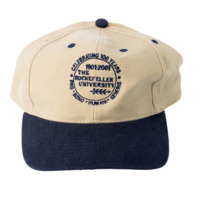 Baseball cap
Baseball cap This cap, which belonged to Roderick MacKinnon, has the logo of Rockefeller University, where he worked.
Roderick MacKinnon donated the cap to the Nobel Prize Museum in 2003.
-
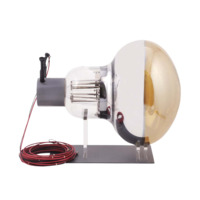 Photomultiplier
Photomultiplier This photomultiplier tube represents Masatoshi Koshiba's research at the Kamiokande and Super-Kamiokande facilities in Japan. These large facilities are located in a water-filled mine. More than 1,000 photomultiplier tubes were placed in the Super-Kamiokande.
Neutrinos are elusive particles that can arise in nuclear reactions in the sun and during supernova explosions. Only one in a trillion neutrinos are stopped on their way through planet earth. When this happens, an electron is formed that generates a small flash of light. To prove the existence of neutrinos, Masatoshi Koshiba used photomultipliers like this one. The photomultiplier captured the flashes and amplified them so that they could be registered.
Masatoshi Koshiba donated the photomultiplier to the Nobel Prize Museum in 2002.
-
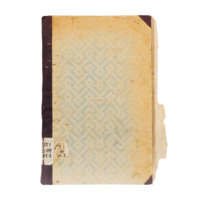 Mathematics textbooks
Mathematics textbooks Amartya Sen used these maths textbooks at school. They are in Hindi, even though this is not the most common language in West Bengal, where he grew up. Mathematics is important in economics, a field where Sen conducted groundbreaking studies.
Amartya Sen donated the textbooks to the Nobel Prize Museum in 2001.
-
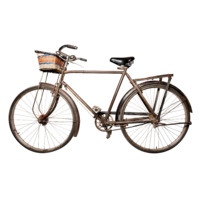 Bicycle
Bicycle A bicycle is not the most commonly-used tool in economic science, but Amartya Sen's bicycle has had a special significance in his research. A large part of his work is concerned improving conditions for the most impoverished members of society. In a study on differences between infant girls and boys, he employed an assistant to weigh the children. Problems arose when the children did not want to be weighed and bit the assistant. The episode ended with Amartya Sen bicycling through the countryside of West Bengal to weigh the infants himself.
Amartya Sen donated the calligraphy to the Nobel Prize Museum in 2001.
-
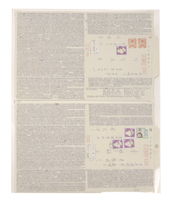 Letters (facsimiles)
Letters (facsimiles) In prison Kim Dae-jung was only allowed one sheet of paper per month. The letters to his wife Lee Hee-ho had to be written with small characters.
Kim Dae-jung donated the facsimiles of the letters to the Nobel Prize Museum in 2001.
-
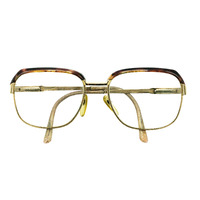 Glasses
Glasses These glasses belonged to Kim Dae-jung.
Kim Dae-jung donated the glasses to the Nobel Prize Museum in 2001.
-
 Bible
Bible The Bible was a key source of energy for Kim Dae-jung. His struggle for democracy in South Korea led to attempts on his life, imprisonment and forced exile. Thanks to support from the South Korean people and democratic efforts around the world, he could keep on fighting. But his deep personal faith also gave him strength. In his Nobel Prize Lecture he said: “I have lived, and continue to live, in the belief that God is always with me.”
Kim Dae-jung donated the bible to the Nobel Prize Museum in 2001.
-
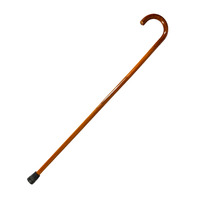 Walking stick
Walking stick This walking stick belonged to Kim Dae-jung.
Kim Dae-jung donated the walking stick to the Nobel Prize Museum in 2001.
-
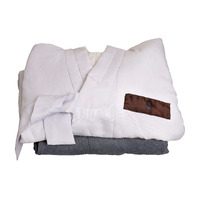 Clothes worn in prison
Clothes worn in prison These clothes were worn by Kim Dae-jung during his time in prison. After being sentenced to death in 1981, Kim Dae-jung was sent to the Chungju prison. Visits from his family were restricted. Kim’s wife Lee Hee-ho knitted clothes and blankets to give more warmth than the prison uniform. The death sentence was later commuted, and he was allowed in 1982 to go into exile in the United States.
Kim Dae-jung donated the prison clothes to the Nobel Prize Museum in 2001.
-
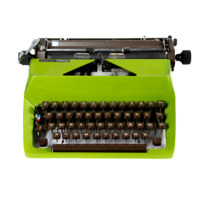 Typewriter
Typewriter Joseph Brodsky used to always pack two portable typewriters on his travels, one for Latin characters and one with the Cyrillic alphabet. But he didn't need to think of that when he spent his summers in Sweden in 1988–1994, because the writer Bengt Jangfeldt let him borrow this typewriter with Cyrillic characters.
Brodsky often had problems with machines with complicated features. That was one of the reasons why he never switched to computers, even though this would have enabled him to alternate freely between Latin and Cyrillic letters without having to drag two typewriters around with him. According to Bengt Jangfeldt, "the clatter of the typewriter and the imprint of black letters on white paper was a veritable holy process" for Brodsky.
The typewriter was donated to the Nobel Prize Museum by Bengt Jangfeldt in 2023.
-
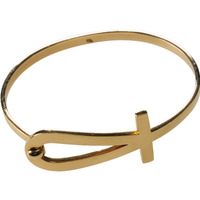 Bracelet
Bracelet Kofi Annan’s bracelet has an ankh symbol, an Egyptian hieroglyphic symbol which has been interpreted as “the key to life”. The Copts – a Christian people of Egypt – retained the symbol in their depiction of the cross used in Christian churches.
The ankh symbol reflects Kofi Annan's primary goal with his work on behalf of the United Nations: to save and improve people’s lives. He bought the bracelet when he was stationed in Cairo with the Sinai peace-keeping forces.
In his book Interventions: A life in War and Peace, Annan describes his work in Egypt:
“I had been sent to Egypt as chief administrative officer for civilian personnel serving in the peacekeeping operation that was under way. The UN Emergency Force in Egypt (known as UNEF II) was stationed to supervise the withdrawal of forces from the Sinai Peninsula after the 1973 Arab-Israeli War. The job of the force was to demarcate the cease-fire line between the Egyptians and Israelis, and reinforce both parties’ confidence in the other’s commitment to the ‘line in the sand.’ The mission was beset with complications, as all peacekeeping operations were, which affected my work every single day: there were administrative and logistical challenges arising from a force made up of multiple troop-contributing nations, including Finland, Sweden, Peru, Ireland, Canada, Poland, Panama, and others. This meant multiple lines of command and logistics chains, numerous languages, clashes in military and administrative cultures, and irregular fluctuations in the size of the force, as different countries provided and withdrew troops at different times.”
Kofi Annan donated the bracelet to the Nobel Prize Museum in 2010.
-
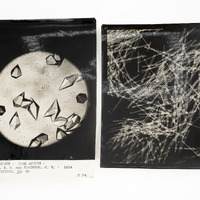 Micrographs of crystals
Micrographs of crystals These micrographs of crystals show substances closely related to pepsin and chymotrypsin, enzymes that are active in digestion. John Northrop managed in 1929 to produce a pure crystal form of these enzymes. His studies revealed that they are proteins.
The photographs were donated to the Nobel Prize Museum by the Northrop family in 2009.
-
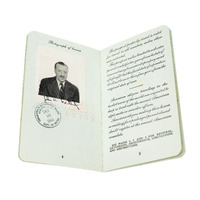 Passport
Passport This passport was issued to John Northrop for his trip to Sweden in December 1946 to attend Nobel Prize award ceremony.
The passport was donated to the Nobel Prize Museum by John Northrop’s family in 2009.
-
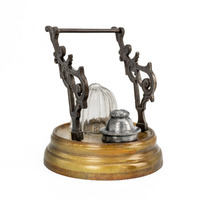 Inkstand
Inkstand This inkstand belonged to John Northrop.It includes an inkwell, which was used to store ink during writing with a quill or dip pen.
The inkstand was donated to the Nobel Prize Museum by the Northrop family in 2009.
-
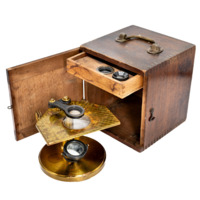 Microscope
Microscope This microscope belonged to John Northrop. It was made by the distinguished microscope maker Joseph Zentmayer in Philadelphia.
The microscope was donated to the Nobel Prize Museum by the Northrop family in 2009.
-
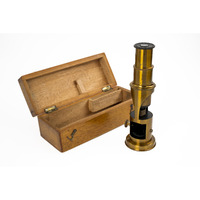 Pocket field microscope
Pocket field microscope This small microscope belonged to John Northrop. who probably used it when he was young. Northrop spent his entire life dedicated to chemistry, in which he made ground-breaking discoveries on proteins.
-
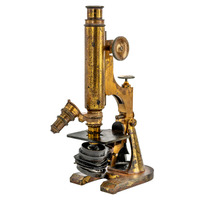 Microscope
Microscope This microscope, which belonged to John Northrop, was made by the distinguished microscope maker Joseph Zentmayer in Philadelphia. This model was patented in 1876. Northrop was born in 1891 and was likely given the microscopes when he was young. Perhaps he inherited it from his father, a zoologist who died tragically in an explosion two weeks before his son’s birth. John Northrop dedicated his entire life to chemistry, making ground-breaking discoveries on proteins.
The microscopes were donated to the Nobel Prize Museum by the Northrop family in 2009.
-
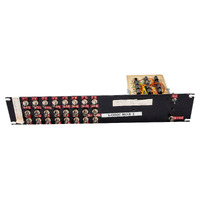 Control panel
Control panel This electronic control panel was used by Wolfgang Ketterle in experiments to create “Bose-Einstein condensates”. The electronic control panel was built by the researchers themselves. It was installed between the experimental apparatus and a computer to protect against water failure in the cooling of the coils in the apparatus.
Wolfgang Ketterle donated the equipment to the Nobel Prize Museum in 2001.
-
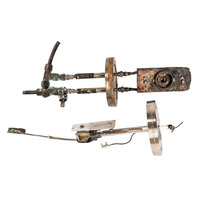 Atomic beam shutter
Atomic beam shutter This atomic beam shutter in two parts was used by Wolfgang Ketterle to create “Bose-Einstein condensates” in experiments in 1994–2001 .
Wolfgang Ketterle donated the atomic beam shutter to the Nobel Prize Museum in 2001.
-
 Coil
Coil This coil was used in Wolfgang Ketterle's experiments in 1996 to create “Bose-Einstein condensates”. The material called that keeps the coil together is epoxy. The coil was cooled by water through the tubes.
Wolfgang Ketterle donated the coil to the Nobel Prize Museum in 2001.
-
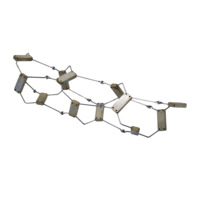 Model of a helical molecular structure
Model of a helical molecular structure In 1948, Linus Pauling was trying to determine the three-dimensional structure of a component found in many biologically important molecules. He found the key to the solution while recovering from a cold, when he was bored and drew the molecular chain on a piece of paper and then folded the paper into a tube. He realised that the structure was helical. It is now known as alpha helix.
The model was presented to the Nobel Prize Museum by Linda Pauling Kamb in 2000.
-
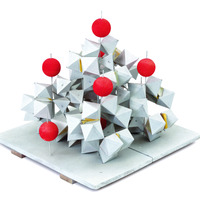 Model of the crystal structure of the mineral zunyite
Model of the crystal structure of the mineral zunyite This model was built by Ava Helen and Linus Pauling in the 1930s. It represents the crystal structure of the mineral zunyite, one of the many structures Linus Pauling discovered.
The model was presented to the Nobel Prize Museum by Linda Pauling Kamb in 2000.
-
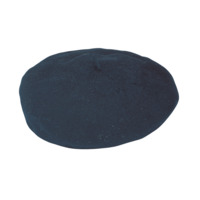 Beret
Beret Linus Pauling often wore a beret. With this artistic headgear, he demonstrated his radical standpoint during the Cold War in the USA. After the atom bomb was dropped on Hiroshima, the chemist Pauling engaged in the fight against nuclear weapons. His activism led to accusations of communist sympathies, and his passport was revoked.
The beret was presented to the Nobel Prize Museum by Linda Pauling Kamb in 2000.
-
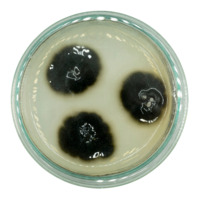 Mould
Mould This dish contains mould from the Penicillium family. It was cultivated from the mould discovered by Alexander Fleming in 1928 in a dish that had been left standing in his laboratory. He noted that the mould had inhibited growth of the bacteria that the dish had been used for. It turned out that the mould had formed a substance, penicillin, which was later used in treatments for bacterial infections.
Ernst Boris Chain, Howard Florey and their colleagues succeeded in the early 1940s to produce penicillin in pure form and investigate its properties in greater detail. Additional efforts led to a drug that could be produced in large quantities.
A penicillium culture was given in 2001 to the Nobel Prize Museum by the Alexander Fleming Laboratory Museum at St Mary's Hospital in London. The culture is kept at the Karolinska Institutet, which regularly supplies the Nobel Prize Museum with a new dish of Penicillium culture.
-
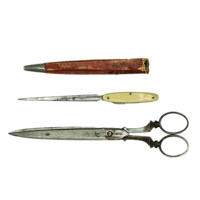 Scissors and letter-knife
Scissors and letter-knife A pair of scissors and a letter-knife are from the desk of William Butler Yeats.
The scissors and the letter-knife were donated to the Nobel Prize Museum in 2001.
-
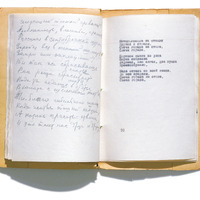 Samizdat booklet
Samizdat booklet This samizdat booklet with “Yuri Zhivago’s poems” by Boris Pasternak was written in the late 1940s. Samizdat was underground literature that circulated in the Soviet Union and Eastern Europe during the communist regimes. Pasternak's novel Doctor Zhivago, which ends with a cycle of poems, was banned in the Soviet Union. In the booklet there are notes by Olga Ivinskaya, whom Pasternak lived with.
The booklet was presented to the Nobel Prize Museum by the Pasternak family in 2000.
-
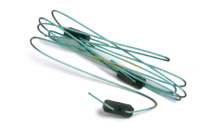 Parts of an antenna system for a radio telescope
Parts of an antenna system for a radio telescope This is a part of an antenna system which was designed and constructed in the 1960’s by a team led by astrophysicist Antony Hewish. The entire system covered a large field outside Cambridge, UK.
A young graduate student, Jocelyn Bell, observed a source of radiation which had not registered before. Further research verified that a new type of star had been discovered – a pulsar.
For the discovery of pulsars Antony Hewish was awarded the Nobel Prize in Physics of 1974. A controversy broke out where several people argued that Jocelyn Bell should have been awarded a share of the prize.
Antony Hewish donated parts of the antenna system to the Nobel Prize Museum in 2001.
-
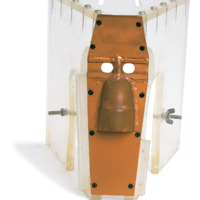 Training box
Training box Using this box, Sperry studied apes whose hemisphere-connecting nerves had been cut.
In the monkey’s brain, the right and left visual fields are connected to the opposite hemisphere. Using filters in front of the monkey's eyes, the right or left field of vision could be shielded. In this way, an image projected on a screen in front of the monkey could be shown to only one hemisphere of the brain. This made it possible to train and study the two brain hemispheres separately. The studies provided a basis for studying the different functions of the two brain hemispheres in humans.
Roger Sperrys widow, Norma Sperry, presented the training box to the Nobel Prize Museum in 2001.
-
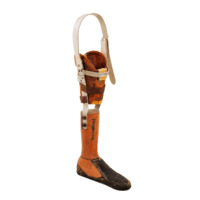 Prosthetic leg
Prosthetic leg This prosthetic leg was produced by Handicap International (now Humanity & Inclusion), an organisation founded in 1982 to help refugees in camps in Thailand and Cambodia. Activities eventually expanded to other countries suffering from conflicts and catastrophes. It co-founded the International Campaign to Ban Landmines, the ICBL.
The prosthetic leg was donated to the Nobel Prize Museum by Humanity & Inclusion in 2001.
-
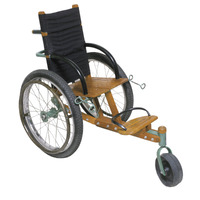 Wheelchair
Wheelchair The Mekong wheelchair was made In Cambodia, where many people have lost one or both legs due to landmines. The wheelchair was made by the Jesuit Refugee Service, a member of the ICBL, the International Campaign to Ban Landmines. The ICBL began operating in 1991 and is an umbrella for numerous people and organisations. At the Nobel Peace Prize ceremony in 1997, the ICBL was represented by Tun Channareth, who began campaigning against landmines after losing both legs in a landmine explosion. He used this Mekong wheelchair at the award ceremony.
The development of the Mekong wheelchair began around 1990. The initiators and designers, David Constantine, Simon Gue, Richard Frost and Ian Harris, have striven to design it in a way that is suitable for low-income countries. They embarked on a partnership with the Jesuit Refugee Service, which has been producing the Mekong wheelchair at its factory in Phnom Penh since 1993.
A lot of wood was used for the wheelchair, since steel was not reliably available in Cambodia at the time. The wheelchairs were flat-packed at the workshop in Phnom Penh and distributed to local workshops where they were assembled.
Due to the country’s poor infrastructure at the time, shipping was a problem. The designers tried to factor in the conditions and still achieve a functional and comfortable product with the available materials.
The wheelchair was donated to the Nobel Prize Museum by the Jesuit Refugee Service in 2001.
-
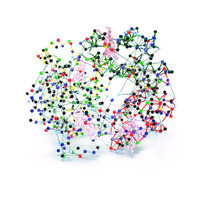 Molecular model of hemoglobine
Molecular model of hemoglobine The model shows the structure of hemoglobin, which was mapped by Max Perutz.
A haemoglobin molecule consists of around ten thousand atoms. In this model, each ball represents an amino acid. The molecule consists of four chains of amino acids. There is one haeme group associated with each chain. The haeme groups are represented by pink balls in the model. At the haeme groups, clefts are formed. These clefts enable the haemoglobin in the blood to transport energising oxygen to the muscles of the body.
The model was acquired by the Nobel Prize Museum on the advice of Max Perutz in 2000.
-
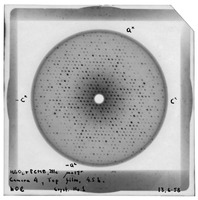 X-ray diffraction photograph
X-ray diffraction photograph This photograph is one of thousands of images that Max Perutz used to map the structure of the hemoglobin molecule. The image shows diffraction patterns caused by x-rays passing through a crystal of hemoglobin molecules taken from blood. The positions of the spots on a large number of X-ray photographs and extensive calculations help determine the molecular structure.
The photograph was presented to the Nobel Prize Museum in 2000 by Max Perutz.
-
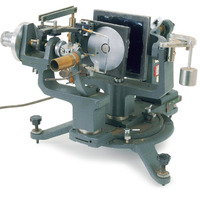 X-ray crystallography camera
X-ray crystallography camera The X-ray camera was used by Max Perutz and John Kendrew in their research on the structure of the proteins hemoglobin and myoglobin.
The camera was invented by mineralogist M. J. Buerger in the early 1940s. On its X-ray diffraction photographs the spots are arranged at the corners of a three¬dimensional lattice which is the reciprocal of the real lattice. These photographs were more straightforward to interpret than the ones taken with other types of camera used before.
The precession camera moves the crystal about one of its axes like a spinning top. Max Perutz and John Kendrew used it together with a home-built X-ray tube with a rotating anode that gave a beam ten times more intense than any commercial tube. Thanks to these instruments they were better equipped for protein crystallography than any other laboratory in the world; this contributed decisively to their solution of the first protein structures.
The camera was presented to the Nobel Prize Museum in 2000 by Max Perutz.
-
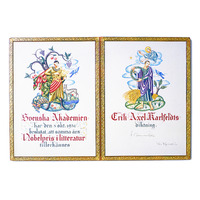 Erik Axel Karlfeldt's Nobel Prize diploma
Erik Axel Karlfeldt's Nobel Prize diploma The 1931 Nobel Prize in Literature was awarded for the poetry of Erik Axel Karlfeldt. Karlfeldt, who had been the permanent secretary of the Swedish Academy, had died a few months before the prize was awarded. Since 1974, Nobel Prizes cannot be awarded posthumously.
The Nobel Prize diploma was created by the artist Berta Svensson-Piehl, who in a letter to Karlfeldt's widow Gerda Karlfeldt in 1945 described the diploma as follows :
“First page: Erik Axel Karlfeldt’s poetry was like a deeply-rooted, fruit-bearing tree, with a fresh spring at its foot.
The figure is a symbol of the art of poetry, a Fridolin with his golden lyre.
At his feet lies a cornucopia with Flora and Pomona. The deer a symbol of the listening audience.
Page 2: The laurel wreath symbolises the Nobel Prize, the golden corn sheaf bowing down to the earth and the figure pointing upwards to the clouds signify that the prize was awarded after the poet’s death.”
The diploma was donated to the Nobel Prize Museum by Erik Axel Karlfeldt's family in 2000.
-
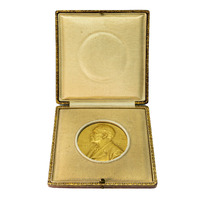 Erik Axel Karlfeldt's Nobel Prize medal
Erik Axel Karlfeldt's Nobel Prize medal The 1931 Nobel Prize in Literature was awarded for the poetry of Erik Axel Karlfeldt. Karlfeldt, who had been the permanent secretary of the Swedish Academy, had died a few months before the prize was awarded. Still, a Nobel Prize medal was made. Since 1974, Nobel Prizes cannot be awarded posthumously.
The medal was donated to the Nobel Prize Museum by Erik Axel Karlfeldt's family in 2000.
 Baseball cap This cap, which belonged to Roderick MacKinnon, has the logo of Rockefeller University, where he worked. Roderick MacKinnon donated the cap to the Nobel Prize Museum in 2003.
Baseball cap This cap, which belonged to Roderick MacKinnon, has the logo of Rockefeller University, where he worked. Roderick MacKinnon donated the cap to the Nobel Prize Museum in 2003. Photomultiplier This photomultiplier tube represents Masatoshi Koshiba's research at the Kamiokande and Super-Kamiokande facilities in Japan. These large facilities are located in a water-filled mine. More than 1,000 photomultiplier tubes were placed in the Super-Kamiokande. Neutrinos are elusive particles that can arise in nuclear reactions in the sun and during supernova explosions. Only one in a trillion neutrinos are stopped on their way through planet earth. When this happens, an electron is formed that generates a small flash of light. To prove the existence of neutrinos, Masatoshi Koshiba used photomultipliers like this one. The photomultiplier captured the flashes and amplified them so that they could be registered. Masatoshi Koshiba donated the photomultiplier to the Nobel Prize Museum in 2002.
Photomultiplier This photomultiplier tube represents Masatoshi Koshiba's research at the Kamiokande and Super-Kamiokande facilities in Japan. These large facilities are located in a water-filled mine. More than 1,000 photomultiplier tubes were placed in the Super-Kamiokande. Neutrinos are elusive particles that can arise in nuclear reactions in the sun and during supernova explosions. Only one in a trillion neutrinos are stopped on their way through planet earth. When this happens, an electron is formed that generates a small flash of light. To prove the existence of neutrinos, Masatoshi Koshiba used photomultipliers like this one. The photomultiplier captured the flashes and amplified them so that they could be registered. Masatoshi Koshiba donated the photomultiplier to the Nobel Prize Museum in 2002. Mathematics textbooks Amartya Sen used these maths textbooks at school. They are in Hindi, even though this is not the most common language in West Bengal, where he grew up. Mathematics is important in economics, a field where Sen conducted groundbreaking studies. Amartya Sen donated the textbooks to the Nobel Prize Museum in 2001.
Mathematics textbooks Amartya Sen used these maths textbooks at school. They are in Hindi, even though this is not the most common language in West Bengal, where he grew up. Mathematics is important in economics, a field where Sen conducted groundbreaking studies. Amartya Sen donated the textbooks to the Nobel Prize Museum in 2001. Bicycle A bicycle is not the most commonly-used tool in economic science, but Amartya Sen's bicycle has had a special significance in his research. A large part of his work is concerned improving conditions for the most impoverished members of society. In a study on differences between infant girls and boys, he employed an assistant to weigh the children. Problems arose when the children did not want to be weighed and bit the assistant. The episode ended with Amartya Sen bicycling through the countryside of West Bengal to weigh the infants himself. Amartya Sen donated the calligraphy to the Nobel Prize Museum in 2001.
Bicycle A bicycle is not the most commonly-used tool in economic science, but Amartya Sen's bicycle has had a special significance in his research. A large part of his work is concerned improving conditions for the most impoverished members of society. In a study on differences between infant girls and boys, he employed an assistant to weigh the children. Problems arose when the children did not want to be weighed and bit the assistant. The episode ended with Amartya Sen bicycling through the countryside of West Bengal to weigh the infants himself. Amartya Sen donated the calligraphy to the Nobel Prize Museum in 2001. Letters (facsimiles) In prison Kim Dae-jung was only allowed one sheet of paper per month. The letters to his wife Lee Hee-ho had to be written with small characters. Kim Dae-jung donated the facsimiles of the letters to the Nobel Prize Museum in 2001.
Letters (facsimiles) In prison Kim Dae-jung was only allowed one sheet of paper per month. The letters to his wife Lee Hee-ho had to be written with small characters. Kim Dae-jung donated the facsimiles of the letters to the Nobel Prize Museum in 2001. Glasses These glasses belonged to Kim Dae-jung. Kim Dae-jung donated the glasses to the Nobel Prize Museum in 2001.
Glasses These glasses belonged to Kim Dae-jung. Kim Dae-jung donated the glasses to the Nobel Prize Museum in 2001. Bible The Bible was a key source of energy for Kim Dae-jung. His struggle for democracy in South Korea led to attempts on his life, imprisonment and forced exile. Thanks to support from the South Korean people and democratic efforts around the world, he could keep on fighting. But his deep personal faith also gave him strength. In his Nobel Prize Lecture he said: “I have lived, and continue to live, in the belief that God is always with me.” Kim Dae-jung donated the bible to the Nobel Prize Museum in 2001.
Bible The Bible was a key source of energy for Kim Dae-jung. His struggle for democracy in South Korea led to attempts on his life, imprisonment and forced exile. Thanks to support from the South Korean people and democratic efforts around the world, he could keep on fighting. But his deep personal faith also gave him strength. In his Nobel Prize Lecture he said: “I have lived, and continue to live, in the belief that God is always with me.” Kim Dae-jung donated the bible to the Nobel Prize Museum in 2001. Walking stick This walking stick belonged to Kim Dae-jung. Kim Dae-jung donated the walking stick to the Nobel Prize Museum in 2001.
Walking stick This walking stick belonged to Kim Dae-jung. Kim Dae-jung donated the walking stick to the Nobel Prize Museum in 2001. Clothes worn in prison These clothes were worn by Kim Dae-jung during his time in prison. After being sentenced to death in 1981, Kim Dae-jung was sent to the Chungju prison. Visits from his family were restricted. Kim’s wife Lee Hee-ho knitted clothes and blankets to give more warmth than the prison uniform. The death sentence was later commuted, and he was allowed in 1982 to go into exile in the United States. Kim Dae-jung donated the prison clothes to the Nobel Prize Museum in 2001.
Clothes worn in prison These clothes were worn by Kim Dae-jung during his time in prison. After being sentenced to death in 1981, Kim Dae-jung was sent to the Chungju prison. Visits from his family were restricted. Kim’s wife Lee Hee-ho knitted clothes and blankets to give more warmth than the prison uniform. The death sentence was later commuted, and he was allowed in 1982 to go into exile in the United States. Kim Dae-jung donated the prison clothes to the Nobel Prize Museum in 2001. Typewriter Joseph Brodsky used to always pack two portable typewriters on his travels, one for Latin characters and one with the Cyrillic alphabet. But he didn't need to think of that when he spent his summers in Sweden in 1988–1994, because the writer Bengt Jangfeldt let him borrow this typewriter with Cyrillic characters. Brodsky often had problems with machines with complicated features. That was one of the reasons why he never switched to computers, even though this would have enabled him to alternate freely between Latin and Cyrillic letters without having to drag two typewriters around with him. According to Bengt Jangfeldt, "the clatter of the typewriter and the imprint of black letters on white paper was a veritable holy process" for Brodsky. The typewriter was donated to the Nobel Prize Museum by Bengt Jangfeldt in 2023.
Typewriter Joseph Brodsky used to always pack two portable typewriters on his travels, one for Latin characters and one with the Cyrillic alphabet. But he didn't need to think of that when he spent his summers in Sweden in 1988–1994, because the writer Bengt Jangfeldt let him borrow this typewriter with Cyrillic characters. Brodsky often had problems with machines with complicated features. That was one of the reasons why he never switched to computers, even though this would have enabled him to alternate freely between Latin and Cyrillic letters without having to drag two typewriters around with him. According to Bengt Jangfeldt, "the clatter of the typewriter and the imprint of black letters on white paper was a veritable holy process" for Brodsky. The typewriter was donated to the Nobel Prize Museum by Bengt Jangfeldt in 2023. Bracelet Kofi Annan’s bracelet has an ankh symbol, an Egyptian hieroglyphic symbol which has been interpreted as “the key to life”. The Copts – a Christian people of Egypt – retained the symbol in their depiction of the cross used in Christian churches. The ankh symbol reflects Kofi Annan's primary goal with his work on behalf of the United Nations: to save and improve people’s lives. He bought the bracelet when he was stationed in Cairo with the Sinai peace-keeping forces. In his book Interventions: A life in War and Peace, Annan describes his work in Egypt: “I had been sent to Egypt as chief administrative officer for civilian personnel serving in the peacekeeping operation that was under way. The UN Emergency Force in Egypt (known as UNEF II) was stationed to supervise the withdrawal of forces from the Sinai Peninsula after the 1973 Arab-Israeli War. The job of the force was to demarcate the cease-fire line between the Egyptians and Israelis, and reinforce both parties’ confidence in the other’s commitment to the ‘line in the sand.’ The mission was beset with complications, as all peacekeeping operations were, which affected my work every single day: there were administrative and logistical challenges arising from a force made up of multiple troop-contributing nations, including Finland, Sweden, Peru, Ireland, Canada, Poland, Panama, and others. This meant multiple lines of command and logistics chains, numerous languages, clashes in military and administrative cultures, and irregular fluctuations in the size of the force, as different countries provided and withdrew troops at different times.” Kofi Annan donated the bracelet to the Nobel Prize Museum in 2010.
Bracelet Kofi Annan’s bracelet has an ankh symbol, an Egyptian hieroglyphic symbol which has been interpreted as “the key to life”. The Copts – a Christian people of Egypt – retained the symbol in their depiction of the cross used in Christian churches. The ankh symbol reflects Kofi Annan's primary goal with his work on behalf of the United Nations: to save and improve people’s lives. He bought the bracelet when he was stationed in Cairo with the Sinai peace-keeping forces. In his book Interventions: A life in War and Peace, Annan describes his work in Egypt: “I had been sent to Egypt as chief administrative officer for civilian personnel serving in the peacekeeping operation that was under way. The UN Emergency Force in Egypt (known as UNEF II) was stationed to supervise the withdrawal of forces from the Sinai Peninsula after the 1973 Arab-Israeli War. The job of the force was to demarcate the cease-fire line between the Egyptians and Israelis, and reinforce both parties’ confidence in the other’s commitment to the ‘line in the sand.’ The mission was beset with complications, as all peacekeeping operations were, which affected my work every single day: there were administrative and logistical challenges arising from a force made up of multiple troop-contributing nations, including Finland, Sweden, Peru, Ireland, Canada, Poland, Panama, and others. This meant multiple lines of command and logistics chains, numerous languages, clashes in military and administrative cultures, and irregular fluctuations in the size of the force, as different countries provided and withdrew troops at different times.” Kofi Annan donated the bracelet to the Nobel Prize Museum in 2010. Micrographs of crystals These micrographs of crystals show substances closely related to pepsin and chymotrypsin, enzymes that are active in digestion. John Northrop managed in 1929 to produce a pure crystal form of these enzymes. His studies revealed that they are proteins. The photographs were donated to the Nobel Prize Museum by the Northrop family in 2009.
Micrographs of crystals These micrographs of crystals show substances closely related to pepsin and chymotrypsin, enzymes that are active in digestion. John Northrop managed in 1929 to produce a pure crystal form of these enzymes. His studies revealed that they are proteins. The photographs were donated to the Nobel Prize Museum by the Northrop family in 2009. Passport This passport was issued to John Northrop for his trip to Sweden in December 1946 to attend Nobel Prize award ceremony. The passport was donated to the Nobel Prize Museum by John Northrop’s family in 2009.
Passport This passport was issued to John Northrop for his trip to Sweden in December 1946 to attend Nobel Prize award ceremony. The passport was donated to the Nobel Prize Museum by John Northrop’s family in 2009. Inkstand This inkstand belonged to John Northrop.It includes an inkwell, which was used to store ink during writing with a quill or dip pen. The inkstand was donated to the Nobel Prize Museum by the Northrop family in 2009.
Inkstand This inkstand belonged to John Northrop.It includes an inkwell, which was used to store ink during writing with a quill or dip pen. The inkstand was donated to the Nobel Prize Museum by the Northrop family in 2009. Microscope This microscope belonged to John Northrop. It was made by the distinguished microscope maker Joseph Zentmayer in Philadelphia. The microscope was donated to the Nobel Prize Museum by the Northrop family in 2009.
Microscope This microscope belonged to John Northrop. It was made by the distinguished microscope maker Joseph Zentmayer in Philadelphia. The microscope was donated to the Nobel Prize Museum by the Northrop family in 2009. Pocket field microscope This small microscope belonged to John Northrop. who probably used it when he was young. Northrop spent his entire life dedicated to chemistry, in which he made ground-breaking discoveries on proteins.
Pocket field microscope This small microscope belonged to John Northrop. who probably used it when he was young. Northrop spent his entire life dedicated to chemistry, in which he made ground-breaking discoveries on proteins. Microscope This microscope, which belonged to John Northrop, was made by the distinguished microscope maker Joseph Zentmayer in Philadelphia. This model was patented in 1876. Northrop was born in 1891 and was likely given the microscopes when he was young. Perhaps he inherited it from his father, a zoologist who died tragically in an explosion two weeks before his son’s birth. John Northrop dedicated his entire life to chemistry, making ground-breaking discoveries on proteins. The microscopes were donated to the Nobel Prize Museum by the Northrop family in 2009.
Microscope This microscope, which belonged to John Northrop, was made by the distinguished microscope maker Joseph Zentmayer in Philadelphia. This model was patented in 1876. Northrop was born in 1891 and was likely given the microscopes when he was young. Perhaps he inherited it from his father, a zoologist who died tragically in an explosion two weeks before his son’s birth. John Northrop dedicated his entire life to chemistry, making ground-breaking discoveries on proteins. The microscopes were donated to the Nobel Prize Museum by the Northrop family in 2009. Control panel This electronic control panel was used by Wolfgang Ketterle in experiments to create “Bose-Einstein condensates”. The electronic control panel was built by the researchers themselves. It was installed between the experimental apparatus and a computer to protect against water failure in the cooling of the coils in the apparatus. Wolfgang Ketterle donated the equipment to the Nobel Prize Museum in 2001.
Control panel This electronic control panel was used by Wolfgang Ketterle in experiments to create “Bose-Einstein condensates”. The electronic control panel was built by the researchers themselves. It was installed between the experimental apparatus and a computer to protect against water failure in the cooling of the coils in the apparatus. Wolfgang Ketterle donated the equipment to the Nobel Prize Museum in 2001. Atomic beam shutter This atomic beam shutter in two parts was used by Wolfgang Ketterle to create “Bose-Einstein condensates” in experiments in 1994–2001 . Wolfgang Ketterle donated the atomic beam shutter to the Nobel Prize Museum in 2001.
Atomic beam shutter This atomic beam shutter in two parts was used by Wolfgang Ketterle to create “Bose-Einstein condensates” in experiments in 1994–2001 . Wolfgang Ketterle donated the atomic beam shutter to the Nobel Prize Museum in 2001. Coil This coil was used in Wolfgang Ketterle's experiments in 1996 to create “Bose-Einstein condensates”. The material called that keeps the coil together is epoxy. The coil was cooled by water through the tubes. Wolfgang Ketterle donated the coil to the Nobel Prize Museum in 2001.
Coil This coil was used in Wolfgang Ketterle's experiments in 1996 to create “Bose-Einstein condensates”. The material called that keeps the coil together is epoxy. The coil was cooled by water through the tubes. Wolfgang Ketterle donated the coil to the Nobel Prize Museum in 2001. Model of a helical molecular structure In 1948, Linus Pauling was trying to determine the three-dimensional structure of a component found in many biologically important molecules. He found the key to the solution while recovering from a cold, when he was bored and drew the molecular chain on a piece of paper and then folded the paper into a tube. He realised that the structure was helical. It is now known as alpha helix. The model was presented to the Nobel Prize Museum by Linda Pauling Kamb in 2000.
Model of a helical molecular structure In 1948, Linus Pauling was trying to determine the three-dimensional structure of a component found in many biologically important molecules. He found the key to the solution while recovering from a cold, when he was bored and drew the molecular chain on a piece of paper and then folded the paper into a tube. He realised that the structure was helical. It is now known as alpha helix. The model was presented to the Nobel Prize Museum by Linda Pauling Kamb in 2000. Model of the crystal structure of the mineral zunyite This model was built by Ava Helen and Linus Pauling in the 1930s. It represents the crystal structure of the mineral zunyite, one of the many structures Linus Pauling discovered. The model was presented to the Nobel Prize Museum by Linda Pauling Kamb in 2000.
Model of the crystal structure of the mineral zunyite This model was built by Ava Helen and Linus Pauling in the 1930s. It represents the crystal structure of the mineral zunyite, one of the many structures Linus Pauling discovered. The model was presented to the Nobel Prize Museum by Linda Pauling Kamb in 2000. Beret Linus Pauling often wore a beret. With this artistic headgear, he demonstrated his radical standpoint during the Cold War in the USA. After the atom bomb was dropped on Hiroshima, the chemist Pauling engaged in the fight against nuclear weapons. His activism led to accusations of communist sympathies, and his passport was revoked. The beret was presented to the Nobel Prize Museum by Linda Pauling Kamb in 2000.
Beret Linus Pauling often wore a beret. With this artistic headgear, he demonstrated his radical standpoint during the Cold War in the USA. After the atom bomb was dropped on Hiroshima, the chemist Pauling engaged in the fight against nuclear weapons. His activism led to accusations of communist sympathies, and his passport was revoked. The beret was presented to the Nobel Prize Museum by Linda Pauling Kamb in 2000. Mould This dish contains mould from the Penicillium family. It was cultivated from the mould discovered by Alexander Fleming in 1928 in a dish that had been left standing in his laboratory. He noted that the mould had inhibited growth of the bacteria that the dish had been used for. It turned out that the mould had formed a substance, penicillin, which was later used in treatments for bacterial infections. Ernst Boris Chain, Howard Florey and their colleagues succeeded in the early 1940s to produce penicillin in pure form and investigate its properties in greater detail. Additional efforts led to a drug that could be produced in large quantities. A penicillium culture was given in 2001 to the Nobel Prize Museum by the Alexander Fleming Laboratory Museum at St Mary's Hospital in London. The culture is kept at the Karolinska Institutet, which regularly supplies the Nobel Prize Museum with a new dish of Penicillium culture.
Mould This dish contains mould from the Penicillium family. It was cultivated from the mould discovered by Alexander Fleming in 1928 in a dish that had been left standing in his laboratory. He noted that the mould had inhibited growth of the bacteria that the dish had been used for. It turned out that the mould had formed a substance, penicillin, which was later used in treatments for bacterial infections. Ernst Boris Chain, Howard Florey and their colleagues succeeded in the early 1940s to produce penicillin in pure form and investigate its properties in greater detail. Additional efforts led to a drug that could be produced in large quantities. A penicillium culture was given in 2001 to the Nobel Prize Museum by the Alexander Fleming Laboratory Museum at St Mary's Hospital in London. The culture is kept at the Karolinska Institutet, which regularly supplies the Nobel Prize Museum with a new dish of Penicillium culture. Scissors and letter-knife A pair of scissors and a letter-knife are from the desk of William Butler Yeats. The scissors and the letter-knife were donated to the Nobel Prize Museum in 2001.
Scissors and letter-knife A pair of scissors and a letter-knife are from the desk of William Butler Yeats. The scissors and the letter-knife were donated to the Nobel Prize Museum in 2001. Samizdat booklet This samizdat booklet with “Yuri Zhivago’s poems” by Boris Pasternak was written in the late 1940s. Samizdat was underground literature that circulated in the Soviet Union and Eastern Europe during the communist regimes. Pasternak's novel Doctor Zhivago, which ends with a cycle of poems, was banned in the Soviet Union. In the booklet there are notes by Olga Ivinskaya, whom Pasternak lived with. The booklet was presented to the Nobel Prize Museum by the Pasternak family in 2000.
Samizdat booklet This samizdat booklet with “Yuri Zhivago’s poems” by Boris Pasternak was written in the late 1940s. Samizdat was underground literature that circulated in the Soviet Union and Eastern Europe during the communist regimes. Pasternak's novel Doctor Zhivago, which ends with a cycle of poems, was banned in the Soviet Union. In the booklet there are notes by Olga Ivinskaya, whom Pasternak lived with. The booklet was presented to the Nobel Prize Museum by the Pasternak family in 2000. Parts of an antenna system for a radio telescope This is a part of an antenna system which was designed and constructed in the 1960’s by a team led by astrophysicist Antony Hewish. The entire system covered a large field outside Cambridge, UK. A young graduate student, Jocelyn Bell, observed a source of radiation which had not registered before. Further research verified that a new type of star had been discovered – a pulsar. For the discovery of pulsars Antony Hewish was awarded the Nobel Prize in Physics of 1974. A controversy broke out where several people argued that Jocelyn Bell should have been awarded a share of the prize. Antony Hewish donated parts of the antenna system to the Nobel Prize Museum in 2001.
Parts of an antenna system for a radio telescope This is a part of an antenna system which was designed and constructed in the 1960’s by a team led by astrophysicist Antony Hewish. The entire system covered a large field outside Cambridge, UK. A young graduate student, Jocelyn Bell, observed a source of radiation which had not registered before. Further research verified that a new type of star had been discovered – a pulsar. For the discovery of pulsars Antony Hewish was awarded the Nobel Prize in Physics of 1974. A controversy broke out where several people argued that Jocelyn Bell should have been awarded a share of the prize. Antony Hewish donated parts of the antenna system to the Nobel Prize Museum in 2001. Training box Using this box, Sperry studied apes whose hemisphere-connecting nerves had been cut. In the monkey’s brain, the right and left visual fields are connected to the opposite hemisphere. Using filters in front of the monkey's eyes, the right or left field of vision could be shielded. In this way, an image projected on a screen in front of the monkey could be shown to only one hemisphere of the brain. This made it possible to train and study the two brain hemispheres separately. The studies provided a basis for studying the different functions of the two brain hemispheres in humans. Roger Sperrys widow, Norma Sperry, presented the training box to the Nobel Prize Museum in 2001.
Training box Using this box, Sperry studied apes whose hemisphere-connecting nerves had been cut. In the monkey’s brain, the right and left visual fields are connected to the opposite hemisphere. Using filters in front of the monkey's eyes, the right or left field of vision could be shielded. In this way, an image projected on a screen in front of the monkey could be shown to only one hemisphere of the brain. This made it possible to train and study the two brain hemispheres separately. The studies provided a basis for studying the different functions of the two brain hemispheres in humans. Roger Sperrys widow, Norma Sperry, presented the training box to the Nobel Prize Museum in 2001. Prosthetic leg This prosthetic leg was produced by Handicap International (now Humanity & Inclusion), an organisation founded in 1982 to help refugees in camps in Thailand and Cambodia. Activities eventually expanded to other countries suffering from conflicts and catastrophes. It co-founded the International Campaign to Ban Landmines, the ICBL. The prosthetic leg was donated to the Nobel Prize Museum by Humanity & Inclusion in 2001.
Prosthetic leg This prosthetic leg was produced by Handicap International (now Humanity & Inclusion), an organisation founded in 1982 to help refugees in camps in Thailand and Cambodia. Activities eventually expanded to other countries suffering from conflicts and catastrophes. It co-founded the International Campaign to Ban Landmines, the ICBL. The prosthetic leg was donated to the Nobel Prize Museum by Humanity & Inclusion in 2001. Wheelchair The Mekong wheelchair was made In Cambodia, where many people have lost one or both legs due to landmines. The wheelchair was made by the Jesuit Refugee Service, a member of the ICBL, the International Campaign to Ban Landmines. The ICBL began operating in 1991 and is an umbrella for numerous people and organisations. At the Nobel Peace Prize ceremony in 1997, the ICBL was represented by Tun Channareth, who began campaigning against landmines after losing both legs in a landmine explosion. He used this Mekong wheelchair at the award ceremony. The development of the Mekong wheelchair began around 1990. The initiators and designers, David Constantine, Simon Gue, Richard Frost and Ian Harris, have striven to design it in a way that is suitable for low-income countries. They embarked on a partnership with the Jesuit Refugee Service, which has been producing the Mekong wheelchair at its factory in Phnom Penh since 1993. A lot of wood was used for the wheelchair, since steel was not reliably available in Cambodia at the time. The wheelchairs were flat-packed at the workshop in Phnom Penh and distributed to local workshops where they were assembled. Due to the country’s poor infrastructure at the time, shipping was a problem. The designers tried to factor in the conditions and still achieve a functional and comfortable product with the available materials. The wheelchair was donated to the Nobel Prize Museum by the Jesuit Refugee Service in 2001.
Wheelchair The Mekong wheelchair was made In Cambodia, where many people have lost one or both legs due to landmines. The wheelchair was made by the Jesuit Refugee Service, a member of the ICBL, the International Campaign to Ban Landmines. The ICBL began operating in 1991 and is an umbrella for numerous people and organisations. At the Nobel Peace Prize ceremony in 1997, the ICBL was represented by Tun Channareth, who began campaigning against landmines after losing both legs in a landmine explosion. He used this Mekong wheelchair at the award ceremony. The development of the Mekong wheelchair began around 1990. The initiators and designers, David Constantine, Simon Gue, Richard Frost and Ian Harris, have striven to design it in a way that is suitable for low-income countries. They embarked on a partnership with the Jesuit Refugee Service, which has been producing the Mekong wheelchair at its factory in Phnom Penh since 1993. A lot of wood was used for the wheelchair, since steel was not reliably available in Cambodia at the time. The wheelchairs were flat-packed at the workshop in Phnom Penh and distributed to local workshops where they were assembled. Due to the country’s poor infrastructure at the time, shipping was a problem. The designers tried to factor in the conditions and still achieve a functional and comfortable product with the available materials. The wheelchair was donated to the Nobel Prize Museum by the Jesuit Refugee Service in 2001. Molecular model of hemoglobine The model shows the structure of hemoglobin, which was mapped by Max Perutz. A haemoglobin molecule consists of around ten thousand atoms. In this model, each ball represents an amino acid. The molecule consists of four chains of amino acids. There is one haeme group associated with each chain. The haeme groups are represented by pink balls in the model. At the haeme groups, clefts are formed. These clefts enable the haemoglobin in the blood to transport energising oxygen to the muscles of the body. The model was acquired by the Nobel Prize Museum on the advice of Max Perutz in 2000.
Molecular model of hemoglobine The model shows the structure of hemoglobin, which was mapped by Max Perutz. A haemoglobin molecule consists of around ten thousand atoms. In this model, each ball represents an amino acid. The molecule consists of four chains of amino acids. There is one haeme group associated with each chain. The haeme groups are represented by pink balls in the model. At the haeme groups, clefts are formed. These clefts enable the haemoglobin in the blood to transport energising oxygen to the muscles of the body. The model was acquired by the Nobel Prize Museum on the advice of Max Perutz in 2000. X-ray diffraction photograph This photograph is one of thousands of images that Max Perutz used to map the structure of the hemoglobin molecule. The image shows diffraction patterns caused by x-rays passing through a crystal of hemoglobin molecules taken from blood. The positions of the spots on a large number of X-ray photographs and extensive calculations help determine the molecular structure. The photograph was presented to the Nobel Prize Museum in 2000 by Max Perutz.
X-ray diffraction photograph This photograph is one of thousands of images that Max Perutz used to map the structure of the hemoglobin molecule. The image shows diffraction patterns caused by x-rays passing through a crystal of hemoglobin molecules taken from blood. The positions of the spots on a large number of X-ray photographs and extensive calculations help determine the molecular structure. The photograph was presented to the Nobel Prize Museum in 2000 by Max Perutz. X-ray crystallography camera The X-ray camera was used by Max Perutz and John Kendrew in their research on the structure of the proteins hemoglobin and myoglobin. The camera was invented by mineralogist M. J. Buerger in the early 1940s. On its X-ray diffraction photographs the spots are arranged at the corners of a three¬dimensional lattice which is the reciprocal of the real lattice. These photographs were more straightforward to interpret than the ones taken with other types of camera used before. The precession camera moves the crystal about one of its axes like a spinning top. Max Perutz and John Kendrew used it together with a home-built X-ray tube with a rotating anode that gave a beam ten times more intense than any commercial tube. Thanks to these instruments they were better equipped for protein crystallography than any other laboratory in the world; this contributed decisively to their solution of the first protein structures. The camera was presented to the Nobel Prize Museum in 2000 by Max Perutz.
X-ray crystallography camera The X-ray camera was used by Max Perutz and John Kendrew in their research on the structure of the proteins hemoglobin and myoglobin. The camera was invented by mineralogist M. J. Buerger in the early 1940s. On its X-ray diffraction photographs the spots are arranged at the corners of a three¬dimensional lattice which is the reciprocal of the real lattice. These photographs were more straightforward to interpret than the ones taken with other types of camera used before. The precession camera moves the crystal about one of its axes like a spinning top. Max Perutz and John Kendrew used it together with a home-built X-ray tube with a rotating anode that gave a beam ten times more intense than any commercial tube. Thanks to these instruments they were better equipped for protein crystallography than any other laboratory in the world; this contributed decisively to their solution of the first protein structures. The camera was presented to the Nobel Prize Museum in 2000 by Max Perutz. Erik Axel Karlfeldt's Nobel Prize diploma The 1931 Nobel Prize in Literature was awarded for the poetry of Erik Axel Karlfeldt. Karlfeldt, who had been the permanent secretary of the Swedish Academy, had died a few months before the prize was awarded. Since 1974, Nobel Prizes cannot be awarded posthumously. The Nobel Prize diploma was created by the artist Berta Svensson-Piehl, who in a letter to Karlfeldt's widow Gerda Karlfeldt in 1945 described the diploma as follows : “First page: Erik Axel Karlfeldt’s poetry was like a deeply-rooted, fruit-bearing tree, with a fresh spring at its foot. The figure is a symbol of the art of poetry, a Fridolin with his golden lyre. At his feet lies a cornucopia with Flora and Pomona. The deer a symbol of the listening audience. Page 2: The laurel wreath symbolises the Nobel Prize, the golden corn sheaf bowing down to the earth and the figure pointing upwards to the clouds signify that the prize was awarded after the poet’s death.” The diploma was donated to the Nobel Prize Museum by Erik Axel Karlfeldt's family in 2000.
Erik Axel Karlfeldt's Nobel Prize diploma The 1931 Nobel Prize in Literature was awarded for the poetry of Erik Axel Karlfeldt. Karlfeldt, who had been the permanent secretary of the Swedish Academy, had died a few months before the prize was awarded. Since 1974, Nobel Prizes cannot be awarded posthumously. The Nobel Prize diploma was created by the artist Berta Svensson-Piehl, who in a letter to Karlfeldt's widow Gerda Karlfeldt in 1945 described the diploma as follows : “First page: Erik Axel Karlfeldt’s poetry was like a deeply-rooted, fruit-bearing tree, with a fresh spring at its foot. The figure is a symbol of the art of poetry, a Fridolin with his golden lyre. At his feet lies a cornucopia with Flora and Pomona. The deer a symbol of the listening audience. Page 2: The laurel wreath symbolises the Nobel Prize, the golden corn sheaf bowing down to the earth and the figure pointing upwards to the clouds signify that the prize was awarded after the poet’s death.” The diploma was donated to the Nobel Prize Museum by Erik Axel Karlfeldt's family in 2000. Erik Axel Karlfeldt's Nobel Prize medal The 1931 Nobel Prize in Literature was awarded for the poetry of Erik Axel Karlfeldt. Karlfeldt, who had been the permanent secretary of the Swedish Academy, had died a few months before the prize was awarded. Still, a Nobel Prize medal was made. Since 1974, Nobel Prizes cannot be awarded posthumously. The medal was donated to the Nobel Prize Museum by Erik Axel Karlfeldt's family in 2000.
Erik Axel Karlfeldt's Nobel Prize medal The 1931 Nobel Prize in Literature was awarded for the poetry of Erik Axel Karlfeldt. Karlfeldt, who had been the permanent secretary of the Swedish Academy, had died a few months before the prize was awarded. Still, a Nobel Prize medal was made. Since 1974, Nobel Prizes cannot be awarded posthumously. The medal was donated to the Nobel Prize Museum by Erik Axel Karlfeldt's family in 2000.